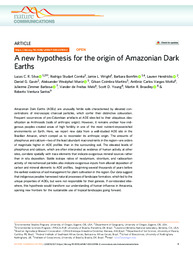A new hypothesis for the origin of Amazonian Dark Earths.
A new hypothesis for the origin of Amazonian Dark Earths.
Author(s): SILVA, L. C. R.; CORRÊA, R. S.; WRIGHT, J. L.; BOMFIM, B.; HENDRICKS, L.; GAVIN, D. G.; MUNIZ, A. W.; MARTINS, G. C.; MOTTA, A. C. V.; BARBOSA, J. Z.; MELO, V. de F.; YOUNG, S. D.; BROADLEY, M. R.; SANTOS, R. V.
Summary: Amazonian Dark Earths (ADEs) are unusually fertile soils characterised by elevated concentrations of microscopic charcoal particles, which confer their distinctive colouration. Frequent occurrences of pre-Columbian artefacts at ADE sites led to their ubiquitous classification as Anthrosols (soils of anthropic origin). However, it remains unclear how indigenous peoples created areas of high fertility in one of the most nutrient-impoverished environments on Earth. Here, we report new data from a well-studied ADE site in the Brazilian Amazon, which compel us to reconsider its anthropic origin. The amounts of phosphorus and calcium - two of the least abundant macronutrients in the region - are orders of magnitude higher in ADE profiles than in the surrounding soil. The elevated levels of phosphorus and calcium, which are often interpreted as evidence of human activity at other sites, correlate spatially with trace elements that indicate exogenous mineral sources rather than in situ deposition. Stable isotope actios of neodymium, strontium, and radiocarbon activity of microcharcoal particles also indicate exogenous inputs from alluvial deposition of carbon and mineral elements to ADE profiles, beginning several thousands of years before the earliest evidence of soil management for plant cultivation in the region. Our data suggest that indigenous peoples harnessed natural processes of landscape formation, which led to the unique properties of ADEs, but were not responsible for their genesis. If corroborated elsewhere, this hypothesis would transform our understanding of human influence in Amazonia, opening new frontiers for the sustainable use of tropical landscapes going forward.
Publication year: 2021
Types of publication: Journal article
Unit: Embrapa Western Amazon
Keywords: Amazonian Dark Earths, Solo, Terra Preta de Índio
Observation
Some of Embrapa's publications are published as ePub files. To read them, use or download one of the following free software options to your computer or mobile device. Android: Google Play Books; IOS: iBooks; Windows and Linux: Calibre.
Access other publications
Access the Agricultural Research Database (BDPA) to consult Embrapa's full library collection and records.
Visit Embrapa Bookstore to purchase books and other publications sold by Embrapa.

